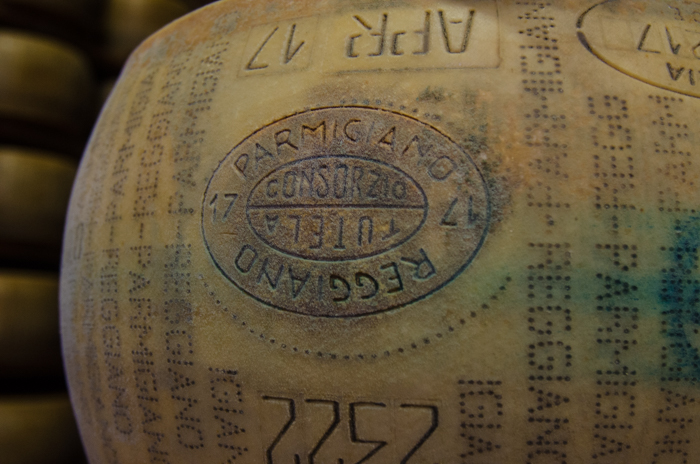 One of the most recognized food products of Italy is the internationally acclaimed Pamiggiano-Reggiano cheese. During our private walking tours of Italy, I introduce the local gourmet products to our guests. In Italy, the identity of these amazing products is entwined – physically, historically, culturally- with their place of origin. Recently I visited the lovely city of Parma in the region of Emilia-Romagna to discover first-hand what goes into producing this world-renowned cheese. I look forward to bring guests on future custom tours to appreciate what goes into the production process.
One of the most recognized food products of Italy is the internationally acclaimed Pamiggiano-Reggiano cheese. During our private walking tours of Italy, I introduce the local gourmet products to our guests. In Italy, the identity of these amazing products is entwined – physically, historically, culturally- with their place of origin. Recently I visited the lovely city of Parma in the region of Emilia-Romagna to discover first-hand what goes into producing this world-renowned cheese. I look forward to bring guests on future custom tours to appreciate what goes into the production process.
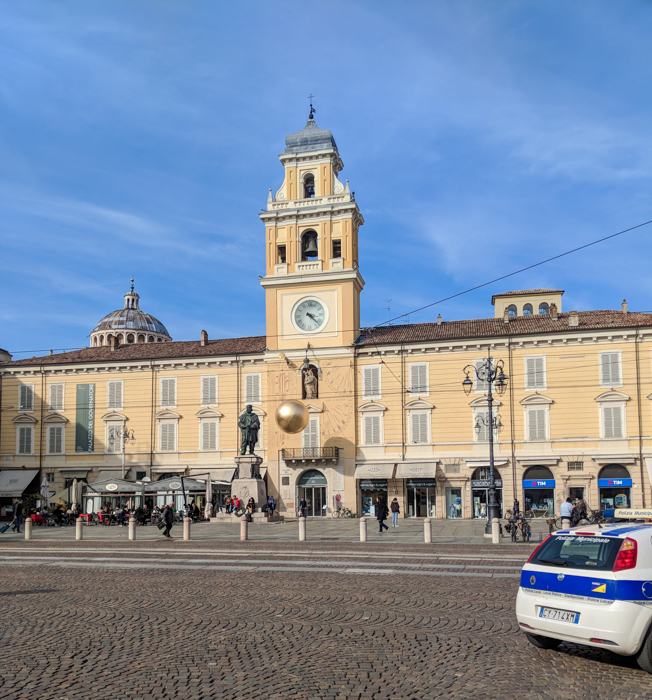
My day begins at 8:30 when my tour guide, Daniela Lanfredi meets me at my hotel. I was connected with Daniela via the great people at Food Valley Tours. I typically set up my own visits to the producers we go to see, but these producers strictly regulate their visitors and you must be accompanied by a guide certified by the production consortium.
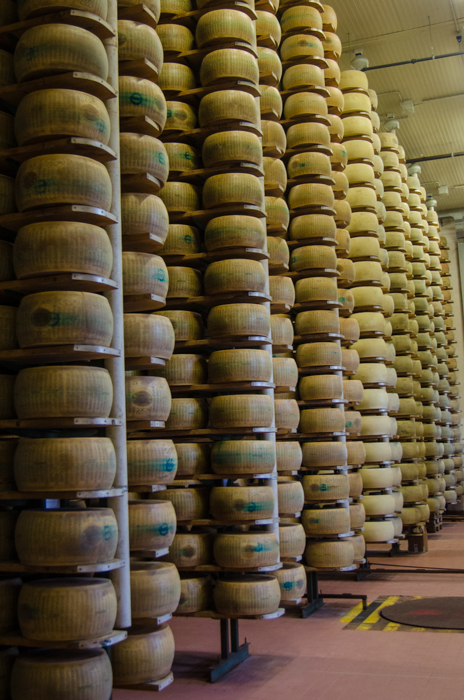
Daniela directs as we drive to Consorzio Produttori Latte Baganzolino, just north of Parma. It’s location is quite close to the city center, but it is encircled by large fields that Daniela assures me will be green with alfalfa in a few weeks. It is a large industrial building, with several barns behind it. These barns are home to the cows, as well as pigs, the reason for the pig’s presence becomes clear later. Today, over 80% of the production of Parmigiano-Reggiano cheese is done in these larger cooperatives, only 20% in smaller, family owned farms. But there still is a “family” that is intimately involved in overseeing the process, as the head cheesemaker and his family live on site. A couple of small children and the family dog greet us as we arrive.
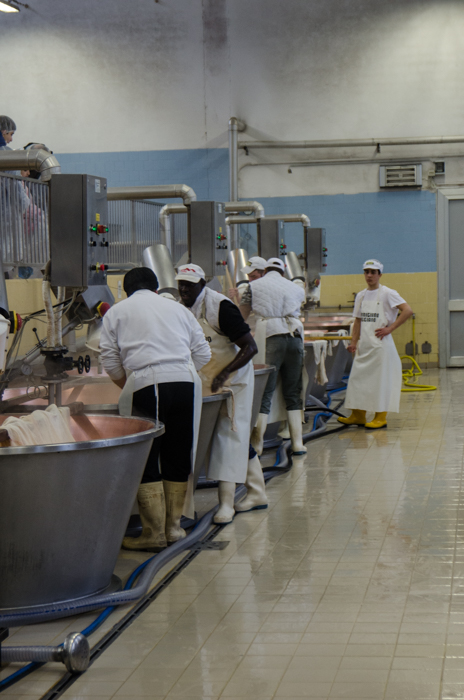
The first order of business is suiting up. Daniela dons her official tour guide lab jacket, then we both cover up with hair nets, plastic coats and shoe coverings – I feel like I’m on a episode of CSI. We get it done more quickly than most groups, as there is only me and I don’t feel the desire to document my new wardrobe with selfies.
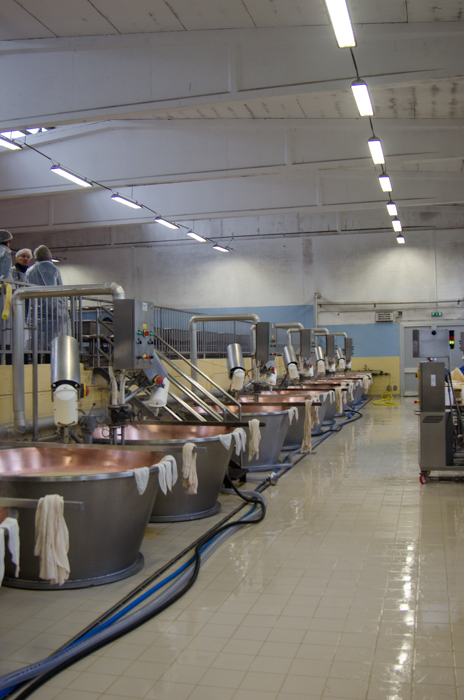
The main floor of the production facility has two levels, separated by a railing. The lower level contains a row of large copper-lined vats, which are currently filled with liquid and steaming. On the upper level is a series of long, flat, rectangular metal troughs with hole and stopper at the end closest to the copper vats.
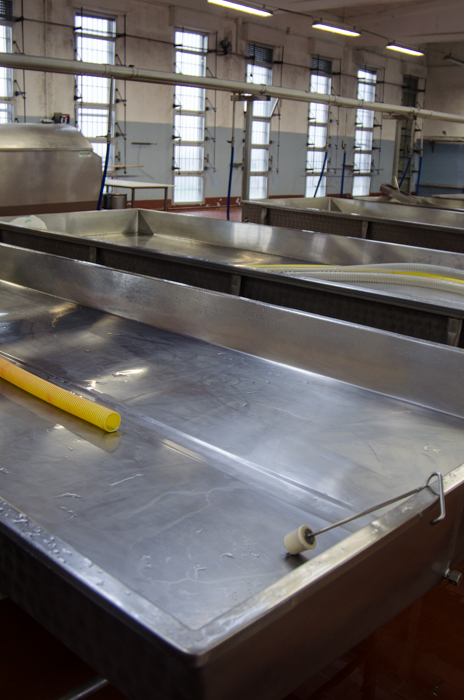
The process begins with the evening milking. The milk is brought immediately from the cows to the metal troughs on the upper level, where it spends the night. One of the key contributors to the esteemed distinctive flavor of Parmigiano-Reggiano cheese is that the milk used is never refrigerated. Refrigeration is believed to compromise the flavor. So the cows must be located at the production facility, and their milk processed immediately. During the night, as the milk rests in the trough, the cream rises to the top. In the morning, the cream is skimmed off, and sent to another plant where it is made into butter. The skimmed milk is then transferred into the copper vats, each filled about halfway.
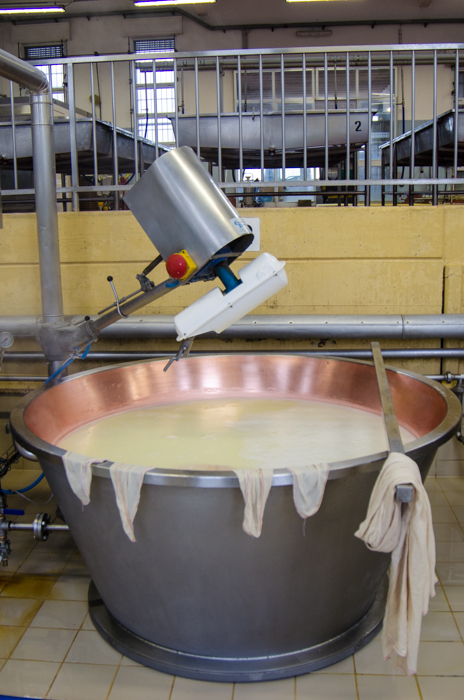
Next, the morning milking arrives, and goes directly into the copper vats, this milk is not skimmed. The cheesemaker then visits the vats and adds just the right amount of rennet to each. Rennet is an enzyme that curdles the casein in milk, separating the curds from the whey. These curds will be pressed into the cheese, the whey has two future uses: some is made into fresh ricotta cheese, the rest goes back to the barns where it is fed to the pigs. This diet of Parmigiano-Reggiano whey contributes to the flavor of another product that Parma is equally famous for, Prosciutto di Parma.
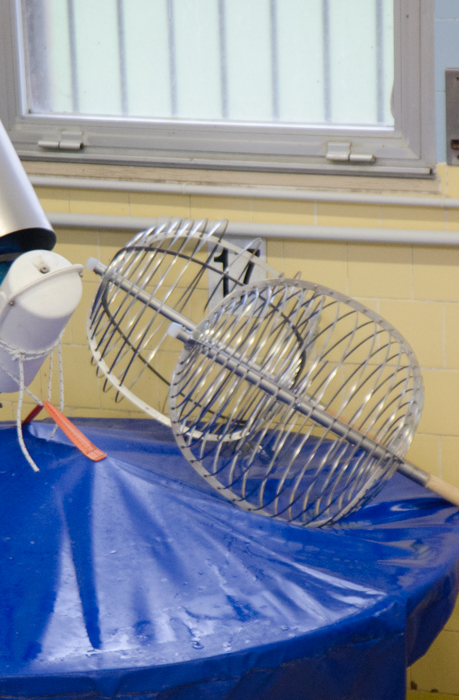
Daniela points out to me the traditional large whisk like tools that are used to manually break up the curds into smaller granules, called a “spino”. The coagulated milk is gently cooked in these heated vats while the curd particles slowly sink to the bottom and begin to stick together, conforming to the bell-shaped bottom of the vat. This is the current state of the production process as we begin our tour.
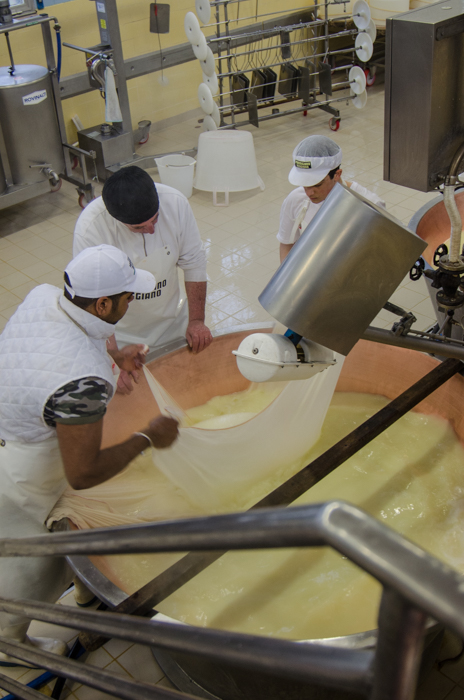
The cheesemaker soon enters and makes his next round, inspecting each copper vat to ensure the curds have settled out. Once he gives the green light, two to three workers descend upon the vat to extract the curds. Using large muslin cloth sheets, two workers carefully lift and roll the curds out of the vats, manipulating them into large rounded cylinders. The muslin sheets containing the rounds are used as a sling, and the rounds are hung from a wooden stick over the trough for a bit before being sliced in half to form two large rounds that will become two large wheels of Parmigiano-Reggiano cheese. Each round is then transferred into a plastic mold that will help keep its shape as the rounds begin to dry. At this point, each wheel is assigned a unique QVC code allowing the producer to trace back each wheel to the cows it came from. In this manner, any issues that turn up in the production process can be diagnosed.
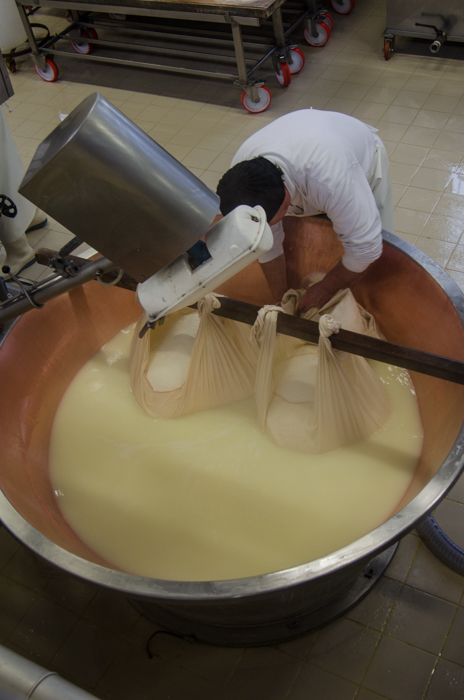
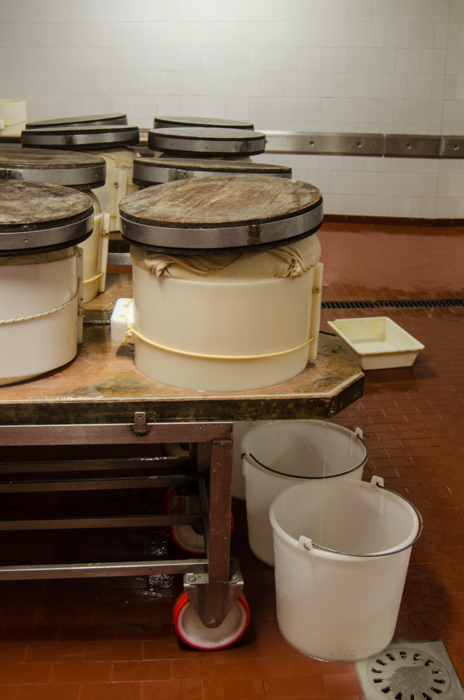
Each round is carefully wrapped up in a sheet of muslin and left in the plastic mold with a weight on top to encourage any remaining whey to drain. These rounds are now moved to a smaller room on a lower floor where they spend the night. They are turned occasionally, and after a few hours a special marking band is wrapped around each wheel. This band engraves the entire exterior with the signature markings that indicate an authentic Parmigiano-Reggiano cheese. These markings include the month and year of production, the dairy registration number and the unmistakable dotted inscription PARMIGIANO-REGGIANO. These marking bands are so tightly controlled that even the official Museum of Parmigiano-Reggiano cheese does not have one.
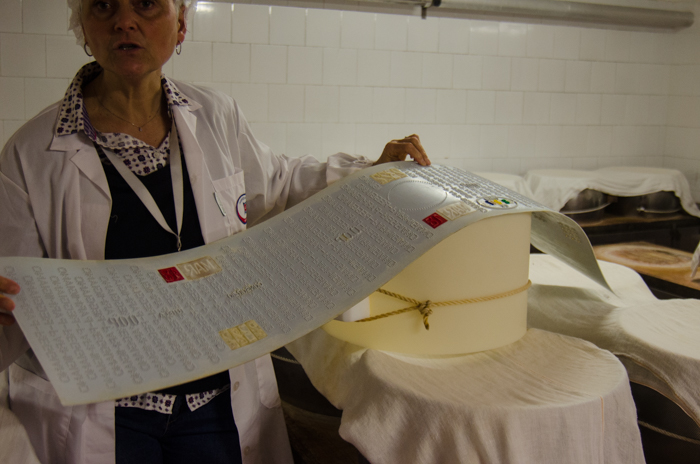
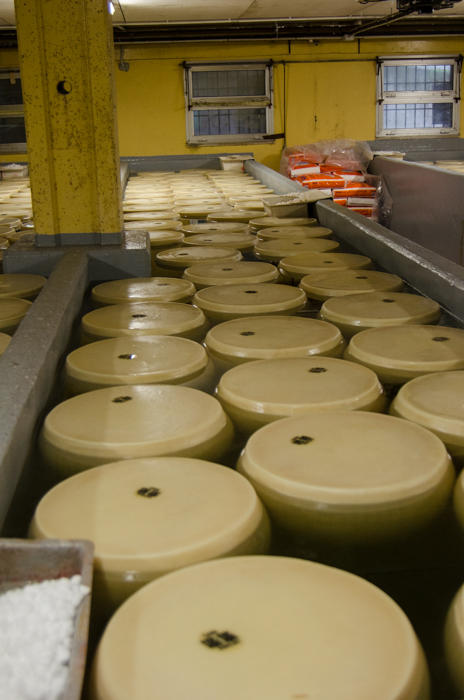
After a couple of days of resting, the rounds removed from the molds and are immersed in a sea salt brine solution. Here the rounds rest for about a month, being turned daily as the sea salt slowly permeates the cheese. This is the last stage of the production process, the cheeses now move on to the maturation rooms.
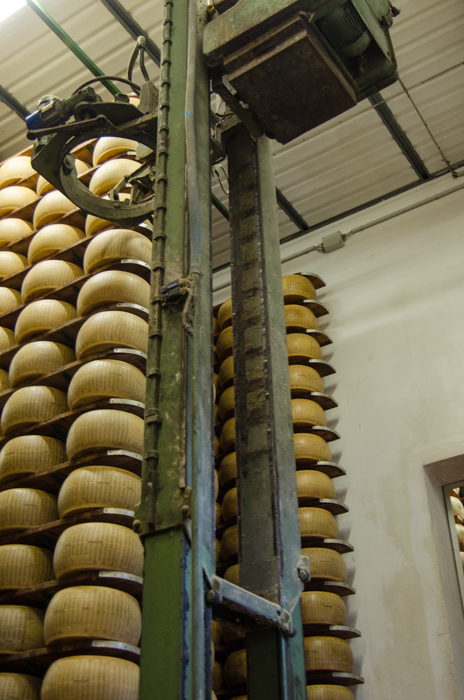
In the large, temperature controlled aging rooms the cheese wheels are laid out in long rows on very impressive shelves that extend probably 30 feet high. The cheeses rest on wooden shelves as the outside of each cheese dries, forming a natural rind. Each cheese is turned and brushed regularly, a specialized machine was developed to reach the high shelves to perform this arduous task; the minimum weight of each wheel is 30kg (just under 70 pounds). The cheeses must rest here for a minimum of 12 months, but can be aged as long as 48 months.
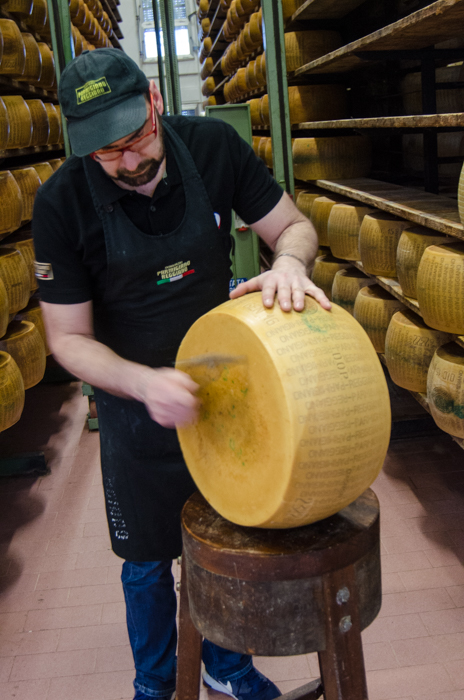
Inspectors from the Consortium visit regularly to examine each cheese. The inspector removes a cheese from the shelf, turns it on its side and places it on stool, then taps it all over. He listens for consistency in the sound of the taps; if he hears hollow sounds, or inconsistent sounds it is an indication of a bubble or some other quality issue with the cheese. When a cheese passes inspection, an official mark is fire-branded onto the cheese indicating it meets the requirements of the Protected Designation of Origin. All identifying marks and the dotted inscriptions are removed from any cheeses which do not meet the PDO requirements. These are sold as ‘seconds’, referred to as “white” cheeses as the golden rind has been removed.
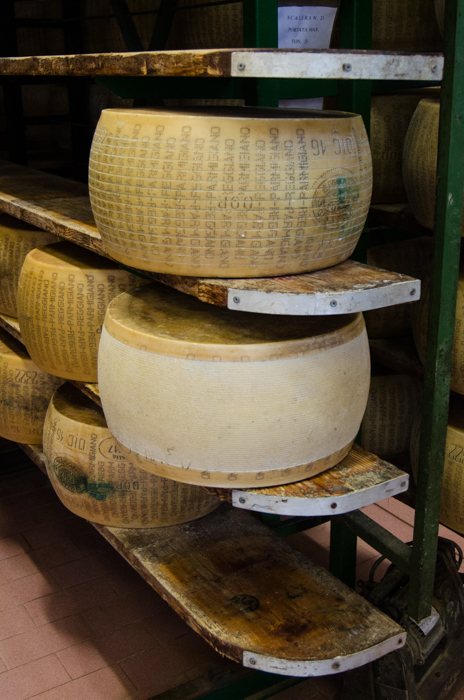
Leaving the aging rooms, we head to the store for our final stop: a tasting of the ultimate product. On our way, Daniela points out a map showing the production area of Parmigiano-Reggiano cheese. Production is restricted to the provinces of Parma, Reggio Emilia, Modena, Bologna, to the west of the Reno River, and Mantua, to the east of the Po River. The production of cheese in this area dates back to the 1200s, when the Benedictine monks here made cheeses in this style to preserve milk. Prior to refrigeration, products like cheeses or prosciutto were made to preserve food for later consumption. The thrifty monks used every by-product of the production process – cream was made into butter, whey into fresh ricotta and fed to the pigs, the casein curds preserved as cheese – and this long tradition continues today.
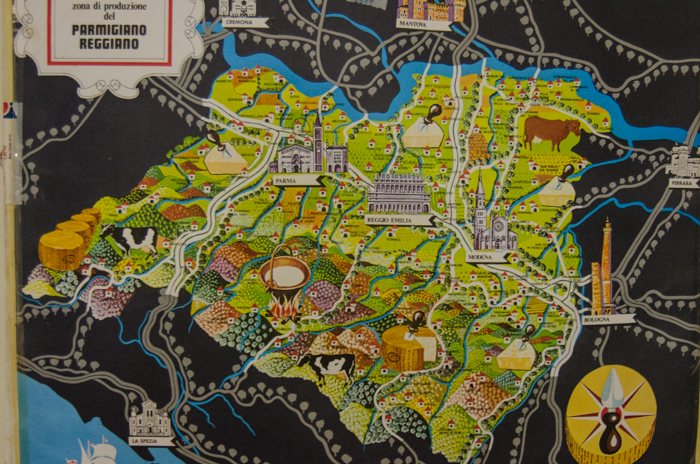
The final stop is a tasting of Parmigiano-Reggiano cheeses, from young 12 months of aging to 48 months. Visually you can see differences between the younger and more mature cheeses, the older cheeses are harder, and as the cheeses age the proteins continue to break down, producing amino acid crystals which are noticeably more prevalent in the older cheeses.
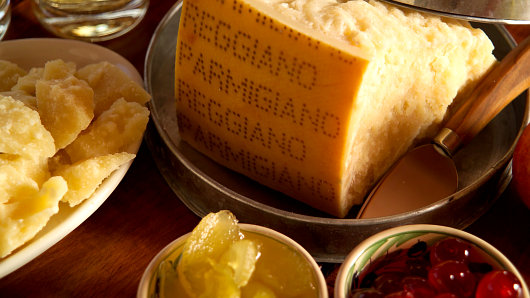
A 12 to 18-month old Parmigiano-Reggiano has a more delicate flavor, and is wonderful as part of an antipasti, accompanied by raw vegetables, fresh fruit, or paired with a mild fruit or fig jam. A 24-month old Parmigiano-Reggiano is best grated on traditional Italian pasta dishes or soups, or served with nuts and dried fruit. Both pair well with white wines or lighter reds.
A 26 to 30-month old Parmigiano-Reggiano would be used to enhance flavor of main courses, served as shavings on meat with a drizzle of extra-virgin olive oil. This longer maturation Parmigiano-Reggiano can be served with fuller bodied red wines. The ultimate indulgence is to pair the most exclusive 48 month aged with a few drops of the thick, luscious Traditional Balsamic Vinegar from Modena or Reggio Emilia.
I have always appreciated the distinctive flavor of an authentic Parmigiano-Reggiano cheese, But after learning about it’s long history and role in the community, seeing first hand the care and passion that the producers put into their product, and their close attention to quality and detail, I can say the respect is has among gourmets is well deserved. As I savor one last bite of the 48 month aged cheese, I agree it is truly the “King of Cheeses”.
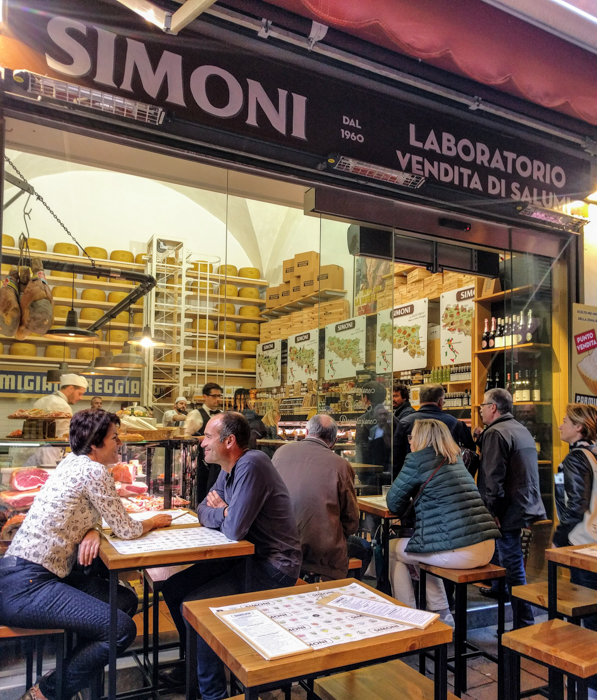

Pingback: Prosciutto di Parma – the King of Hams | Italian Food, Wine, and Travel
Pingback: Insalata di Zucchini e Pinoli | Italian Food, Wine, and Travel | Italian Food, Wine, and Travel
Pingback: Sformato di Parmigiano with Caramelized Pears | Italian Food, Wine, and Travel
Pingback: Prosciutto di Parma – the King of Hams | Italian Food, Wine, and Travel